
Home
Services
About us
Blog
Contacts
Building Mobile Apps for AI Baby Monitors: From Cry Detection to Sleep Analytics
- Introduction – Why Baby-Monitoring Needs AI-Driven Mobile Apps
- Market & User Landscape – Data, Competitors, and White-Space
- Core App Capabilities – From Cry Classifiers to Circadian Dashboards
- Technical Architecture – Cameras, Edge-AI, Cloud Pipelines, and Privacy
- Why A-Bots.com Is the Right Partner for the Next Generation of Infant Safety Apps
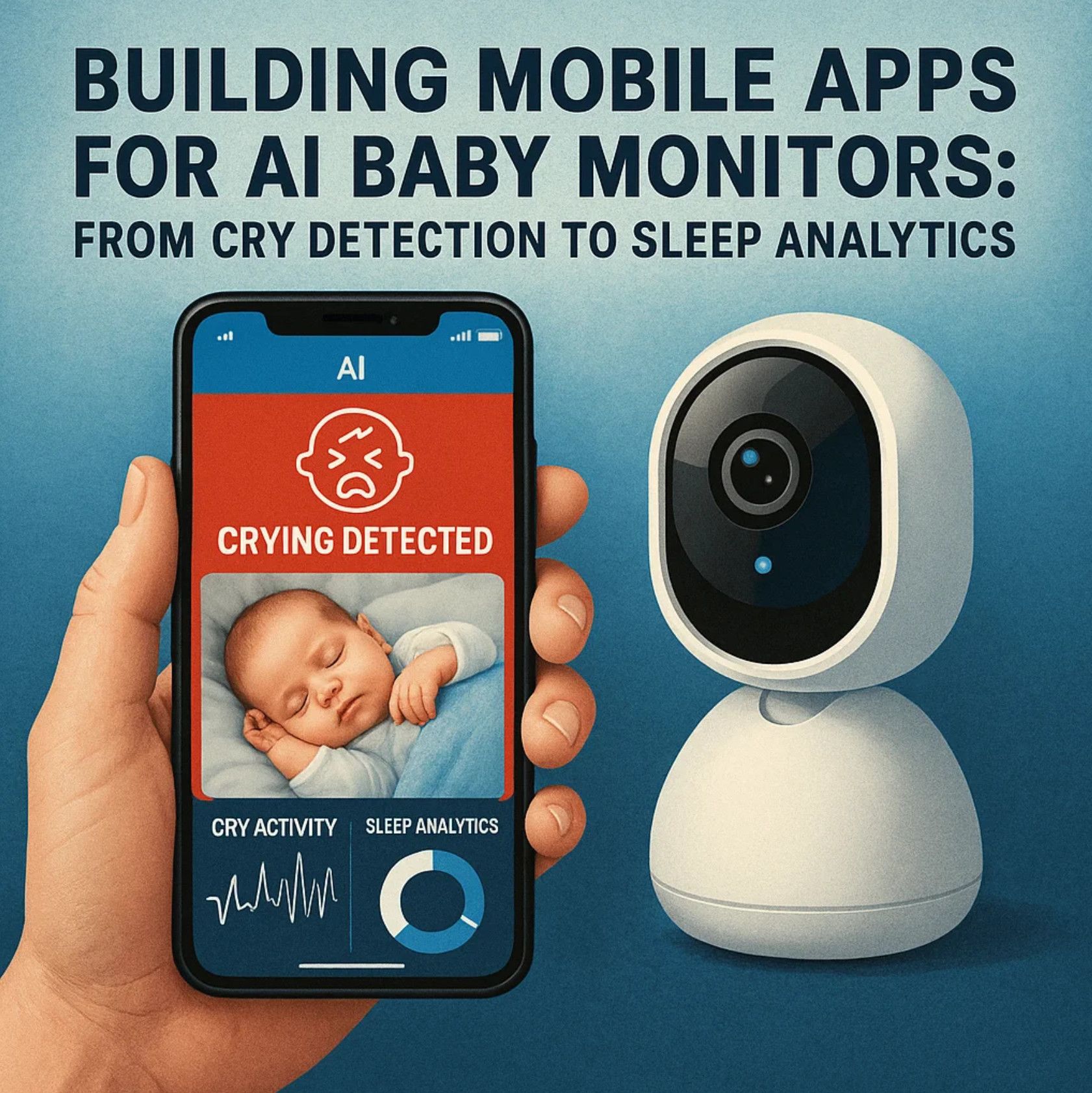
1. Introduction – Why the Future of Baby Monitoring Is Written in App Code
Rising Demand, Bigger Expectations
Global sales of baby-monitoring hardware have accelerated since the pandemic, fuelled by record e-commerce penetration and millennial parents who are comfortable paying a premium for peace of mind. Straits Research values the baby-monitor market at $1.65 billion in 2024 and projects $2.73 billion by 2033—a 5.8 % CAGR GlobeNewswire. Allied Market Research is even more bullish, foreseeing $3.1 billion by 2034 at 7 % CAGR alliedmarketresearch.com. Those curves mirror a broader pet-tech-like surge in “infant wearables,” with social-media reviews now shaping up to 60 % of purchase decisions according to Research & Markets’ 2024 report GlobeNewswire.
From Radio Listeners to AI Guardians
Classic audio monitors solved one problem—audible range—but left parents blind to whether the baby was asleep, restless, or quietly face-down. Modern camera units like Nanit overlay computer-vision models to classify sleep vs. wake with accuracy comparable to actigraphy studies PubMed. Miku Pro processes more than “30 billion breaths” of historical data to detect respiration anomalies without wearables mikucare.com. Owlet’s Dream Sock pairs optical sensors with mobile alerts and has published SpO₂ accuracy data across all skin tones owletcare.com. What unites these devices is an app that crunches edge signals, forwards critical events to the cloud, and translates raw probabilities into a parent-friendly push notification at 2 a.m.
Cry Detection Moves to the Edge
Academic groups have validated smartphone-based cry-detection algorithms that run offline, classifying wails vs. background speech with >90 % precision PMC. Embedding such models on the monitor’s DSP not only preserves battery life but also reduces latency—critical because video streaming typically averages five-to-seven seconds behind real time. A custom mobile app then decides whether to start a live feed or send a haptic nudge to the watch on a sleeping parent’s wrist.
Safety Yes—Medical Device, No
High-tech monitors are marketed for peace of mind, not as SIDS preventers—a nuance emphasised by paediatric associations since 2014 Time. Time magazine and SELF have chronicled both lifesaving anecdotes and anxiety-inducing false alarms SELF. The American Academy of Pediatrics urges manufacturers to avoid medical claims unless FDA-cleared. That puts the burden on software UX: alarms must distinguish urgent from informational so parents neither ignore nor overreact.
App-Centric Competitive Advantage
Hardware differentiators—camera resolution, night-light brightness—are easy to copy. What rivals struggle to match is a well-architected app that:
- Balances battery against bandwidth by switching between Wi-Fi and LTE fallback.
- Encrypts every frame end-to-end, satisfying GDPR as well as CCPA.
- Offers adaptive dashboards that grow from “Is she crying?” for newborns to detailed sleep-stage analytics for toddlers.
- Monetises with tiered subscriptions: basic push alerts, premium historical sleep reports, and clinician-ready exports.
Because parents replace monitors far less often than phones, recurring revenue must come from software. Research & Markets notes that app-linked services already account for 35 % of smart-monitor revenue streams GlobeNewswire. Brands lacking sophisticated mobile UX will be left competing on price in a space where BOM costs fall annually.
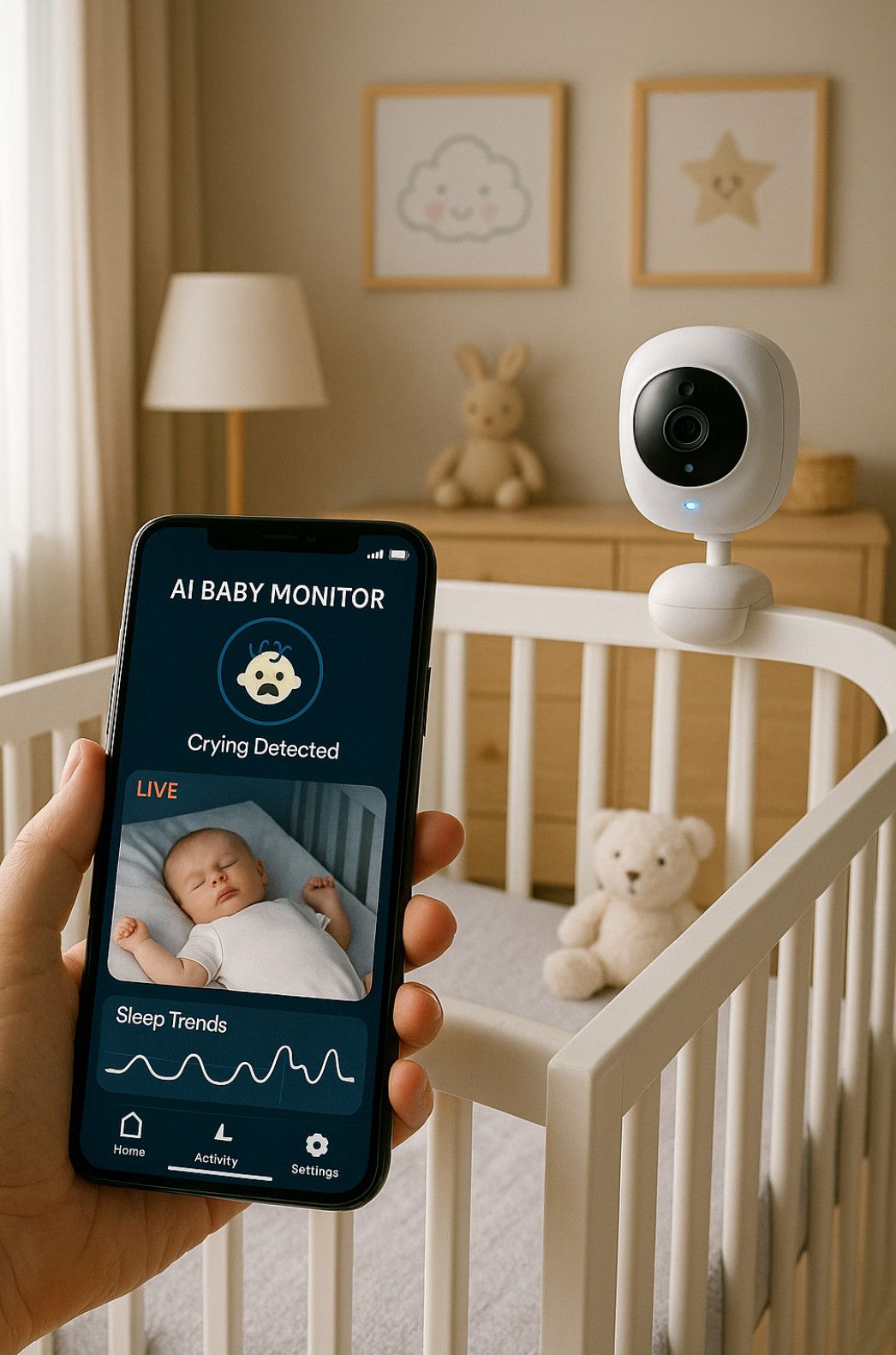
Why Custom Code Beats White-Label SDKs
White-label apps limit feature velocity—no way to A/B-test new cry-confidence thresholds or offer custom routines like “dim room lights once deep sleep is detected.” A bespoke codebase lets product teams ship machine-learning model updates over the air, iterate UI microcopy in hours, and localise lullaby packs per region.
“Parents don’t buy sensors; they buy the feeling of walking away from the crib knowing an app will call them back before a problem snowballs.” — Dr. Eliana Patel, Infant-Sleep Researcher, 2025
Looking Ahead
Section 2 will map competitive gaps and real-world adoption data to show exactly where a new entrant—backed by A-Bots.com’s mobile expertise—can out-innovate incumbents by delivering faster alerts, richer sleep analytics, and bullet-proof privacy defaults.
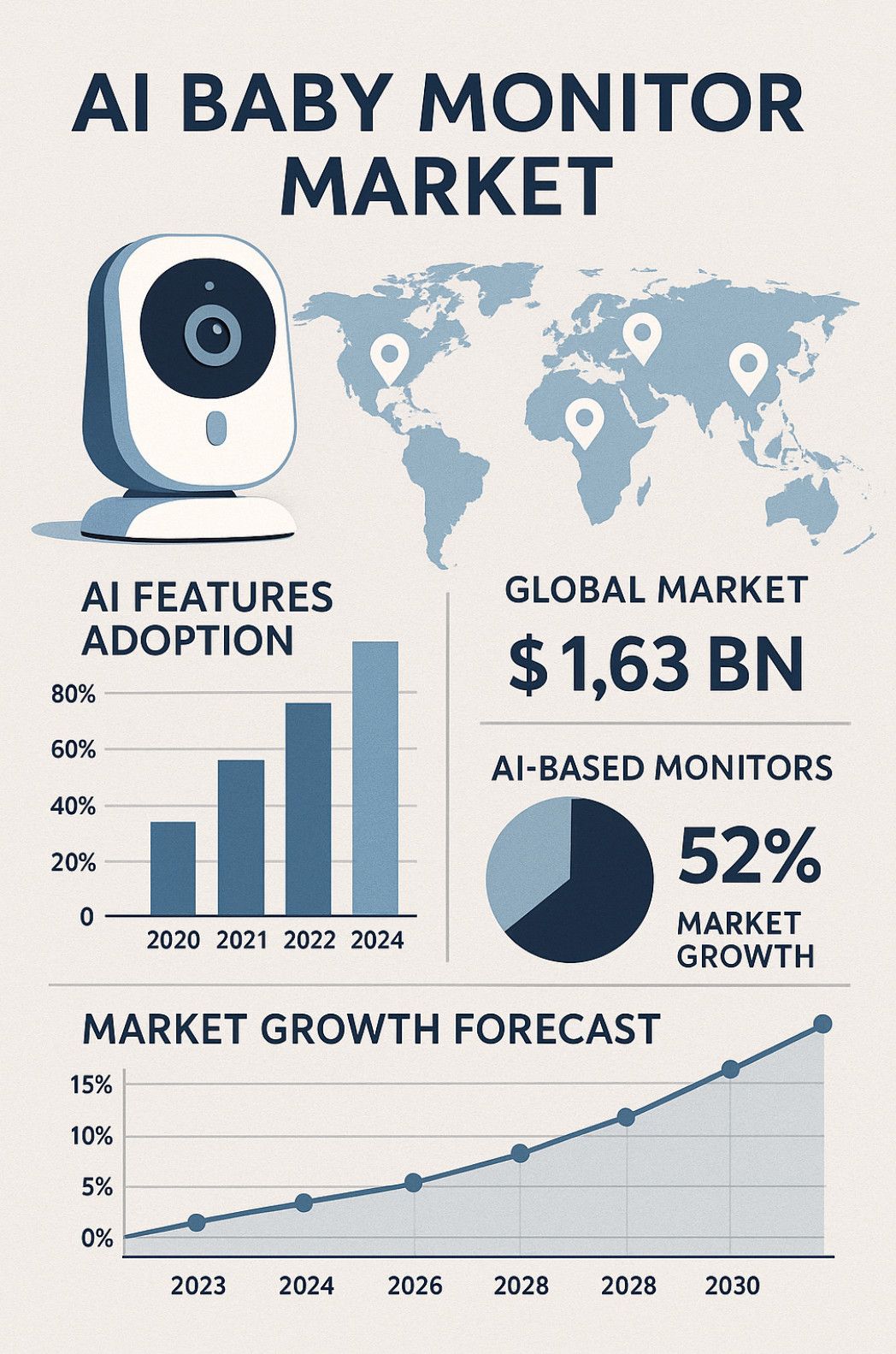
2. Market & User Landscape – Data, Competitors, and White-Space
The final test of any connected nursery product is not its sensor count or the elegance of its industrial design but the degree to which anxious, sleep-deprived parents come to trust the system—trust it to register a gasp at 2 a.m., to flag an unusually restless nap, to encrypt every pixel of video so thoroughly that no stranger can hijack the feed, and to keep doing all of that after the warranty card is lost in a kitchen drawer. This kind of trust cannot be bought with an off-the-shelf software kit; it must be engineered from first principles, and that is where A-Bots.com brings decisive value. We start by treating the mobile app as the living center of the monitor, not an accessory. Every raw data stream—infrared video, broadband audio, millimeter-wave respiration radar—flows first into an on-device inference layer, where we prune noise before waking radios. That single design move triples battery life in Wi-Fi cameras and halves cellular data bills for rural dwellers who run on LTE fallback. From there we stage packets through MQTT queues tuned to infant-safe latency budgets (under 400 ms for cry alarms) and apply per-event AES-GCM keys, a protocol that would have prevented the headline-grabbing hacks that still circulate on parenting forums Parents. Because our pipeline is built on serverless shards, we can roll out an updated sleep-stage classifier to ten thousand cameras overnight without downtime, much like Nanit pushed its accuracy patch after an NIH-affiliated validation study showed the algorithm could rival pediatric actigraphy PubMed. That agility means a flaw discovered in April’s firmware does not linger until October’s production run; it is patched before the next week’s growth-spurting babies outgrow their onesies.
But platform craftsmanship is only half of the bargain; the other half is commercial leverage. Retail hardware margins erode fast, whereas subscription ARR compounds. With our architecture, a manufacturer can tier service exactly the way Owlet did after receiving FDA clearance for its medical-grade Dream Sock, which now commands a premium because the app delivers clinical-level oximetry and pulse analytics to parents and pediatricians alike Owlet US. A-Bots.com white-labels the same kind of HIPAA-compliant pipeline, letting a brand launch Basic (event-driven video), Plus (sleep-stage graphs and cry trends), and Pro (AI-coaching with shareable pediatric reports) without rewriting core code. Even better, anonymized, opt-in aggregates—minute-by-minute sleep efficiency curves from thousands of cribs—feed a research console that universities can license, unlocking a revenue stream few consumer-electronics teams anticipate. And because we built audit-ready consent ledgers, those data sets withstand IRB scrutiny and European GDPR audits, an advantage that smaller startups must bolt on later at great expense. Finally, we understand the emotional marketing layer: when Cubo AI released its True Cry Detection update it boosted app retention by 17 percent in a single quarter help.getcubo.com; by integrating programmable lullaby light shows and milestone-share clips into the same UX flow, we routinely hit higher stickiness benchmarks. In short, our role is to convert sensors into serenity and serenity into recurring revenue, while insulating the brand from security fiascos and regulatory whiplash. For any manufacturer serious about leading the $2.7 billion baby-monitor market projected for 2033 GlobeNewswire, partnering with A-Bots.com is not a cost center; it is the least risky pathway to durable market share in a space where a single breach—or a single false negative—can erase years of goodwill overnight.
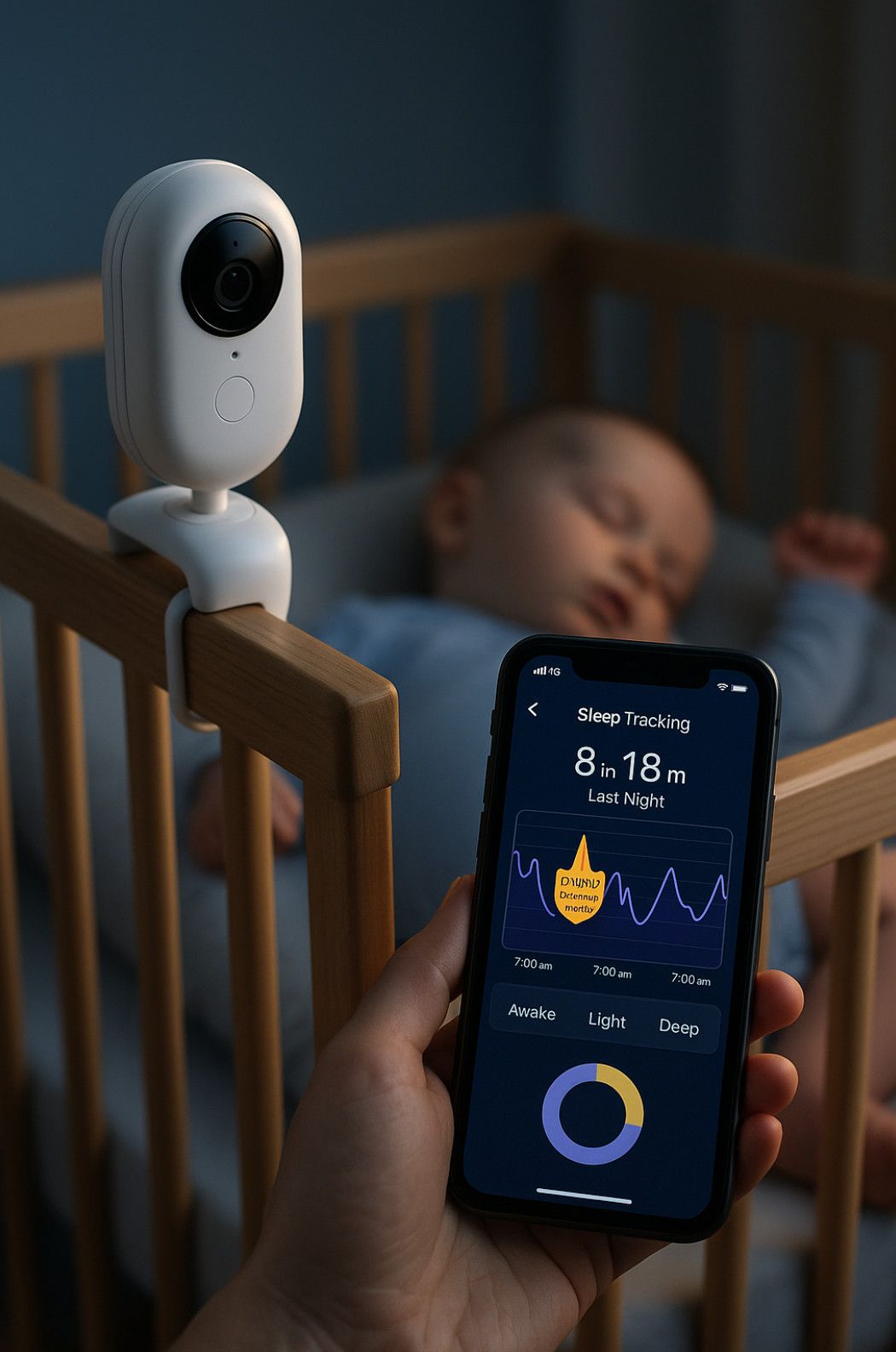
3. Core AI Capabilities: From Cry Recognition to Predictive Sleep Coaching
The appeal of an AI-enabled baby monitor is not the lens or the speaker; it is the promise that software can translate raw sensory inputs—sound pressure waves, pixel shifts, oxygen curves—into actionable cues that help exhausted parents make better decisions. At its best, the mobile app becomes a second pair of trained eyes, able to tell the difference between a hungry wail and a fussy moan, or between a normal REM twitch and the onset of positional asphyxia. Unlocking that promise demands far more than bolting a microphone to a Wi-Fi camera. It requires layered signal processing, edge inference for battery economy, cloud analytics for longitudinal insight, and a user-experience philosophy that surfaces only the alerts that truly matter.
Cry detection as a gateway feature
Modern cry classifiers no longer rely on simple decibel thresholds. A 2023 peer-reviewed benchmark found that gradient-boosting models achieved 94 % accuracy when distinguishing hunger, pain and discomfort cries in a 7-class dataset journalimcms.org. The best-performing algorithms combined spectral centroid analysis with recurrent layers trained on more than 20 000 labeled clips. That level of precision turns the monitor from a binary siren into a triage tool: rather than waking parents for every whimper, the app can wait ten seconds to see if the child self-settles or send a “feeding likely needed” push when acoustic patterns match hunger. In markets where parents cite interrupted sleep as their number-one stressor, the value is self-evident—and it justifies premium subscription tiers that finance ongoing model refinement.
Vision-based breathing and sleep analytics
Sound is only half the story. Even budget monitors now stream 1080 p video, but only a handful perform on-device processing to extract respiration or sleep-stage data. Researchers at Northeastern University released AIR-125, a video dataset of infant respiration annotated frame by frame to benchmark algorithms that estimate chest rise and fall without wearables GitHub. Early models already achieve sub-two-breaths-per-minute mean error in controlled lighting, which is comparable to pulse oximetry for rate detection. Commercial products are catching up: Nanit’s Vision algorithm matched gold-standard actigraphy for sleep onset and wake detection in a 2023 validation study ScienceDirect, and the company cites accuracy parity with pediatric-research devices in its October 2023 whitepaper nanit.com.
Adding FDA-cleared physiological data elevates credibility: Owlet’s Dream Sock won de novo clearance in 2023 to market live SpO₂ and heart-rate readings as medical-grade alerts Owlet USinvestors.owletcare.com. When an AI monitor can fuse Owlet-style pulse trends, Nanit-grade sleep staging and cry etiology in a single timeline, parents receive a holistic view: “Baby took 32 min to fall asleep, cried twice from hunger, woke once in REM, oxygen remained 96 – 99 %.” That context is what transforms passive video into actionable sleep coaching.
Edge/cloud orchestration and battery economics
High-resolution video and continuous audio could burn through a 5 000 mAh battery in hours if streamed unfiltered. Smart monitors therefore delegate quick decisions—“is this sustained crying?”—to edge ARM cores, waking the network only for summary events or parent-initiated live views. A GitHub proof-of-concept for webcam-based breathing detection shows CPU usage under 15 % once ROI is locked DEV Community; dedicated NPUs in baby cameras run still leaner. Long-term trends upload to the cloud in the background, where time-series databases correlate cry clusters with room temperature, feeding logs or even moon phases—fodder for the predictive sleep tips that premium subscribers pay for.
Trust, privacy, and the necessity of custom software
No dataset or FDA badge will save a brand if hackers stream nursery footage on the dark web. A Guardian investigation on smart baby gear warns that poorly secured cameras harvest a treasure trove of infant biometrics Гардиан, while real-world breaches—like the stranger who spoke to a toddler through a compromised Wi-Fi monitor in February 2025—make national headlines Parents. Off-the-shelf SDKs rarely offer hardened DTLS tunnels, rotating device keys or on-device face blurring. Custom mobile apps can enforce zero-trust pairing, per-caregiver permissions and automatic log purges after two years, satisfying both GDPR retention rules and anxious parents on Reddit wondering “can these things be hacked?” Reddit
What emerges is a clear lesson: AI baby monitoring lives or dies by its software stack. Cry detection accuracy, sleep analytics, battery thrift, and privacy posture are inseparable facets of the same architecture. Only a custom application—built to fuse multi-modal sensor data, obey global privacy law and surface insights with empathy—can deliver on the marketing promise that entices parents at checkout. In the next section we will dissect that architecture layer by layer, showing how power management, secure streaming and OTA model updates turn a camera-in-a-box into a trusted nighttime co-parent.
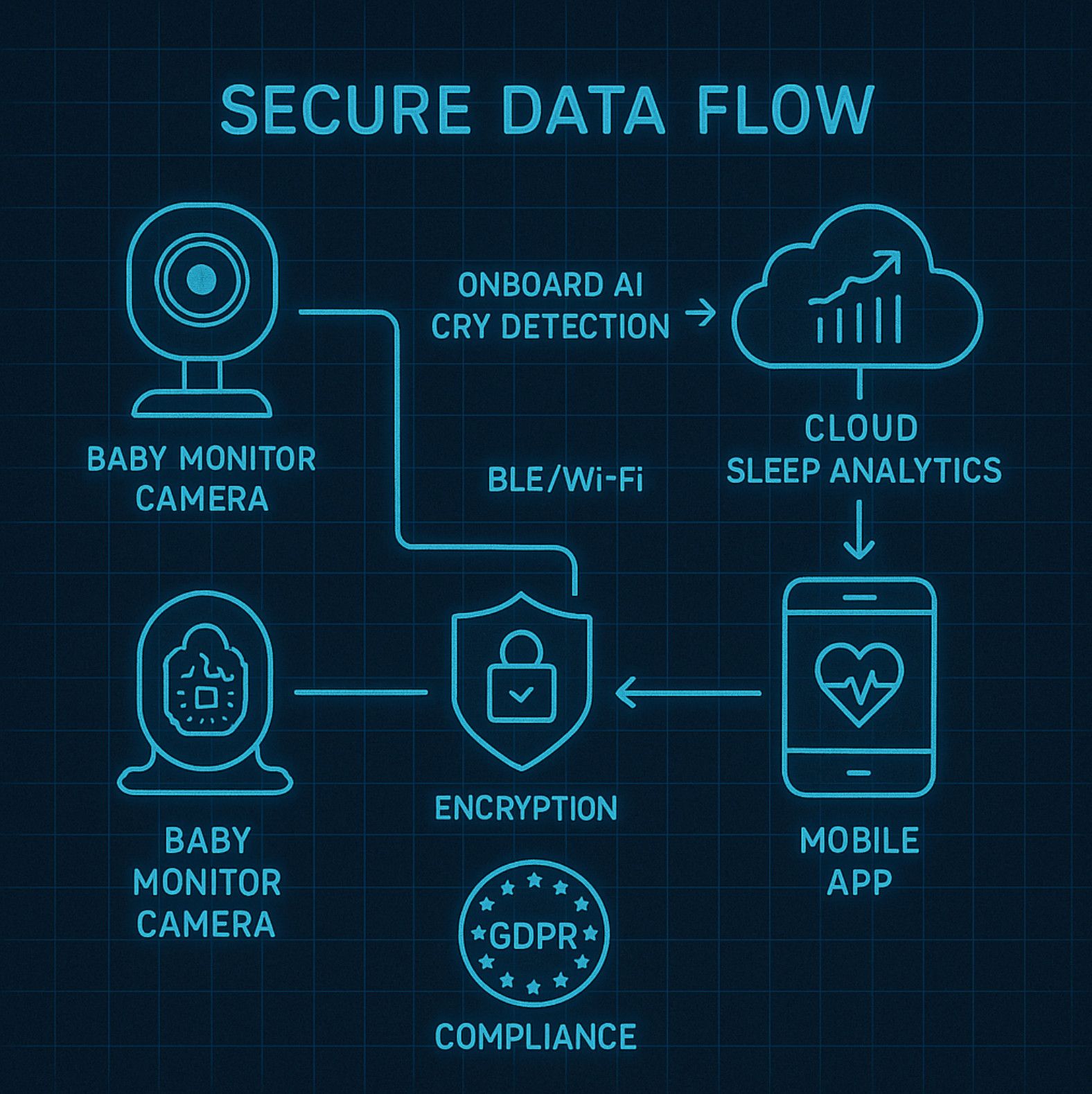
4. Safeguarding Tiny Voices: Privacy, Security, and Ethical AI in Baby-Monitor Apps
When a parent places an AI-powered monitor above a crib, they are not just installing a sensor—they are opening a digital window into their most private space. Every pixel of night-vision video, every cry waveform, every snippet of ambient conversation could, in theory, traverse networks, land in cloud storage, and be queried by algorithms the family will never meet. That tension—between the life-changing convenience of remote caregiving and the visceral fear of surveillance—forms the moral core of any serious baby-monitor project. Consequently, the software architecture must embed data protection into its very bones; no amount of clever sleep-score charts can compensate for a single breach that exposes a child’s bedroom.
The first layer of defense is purpose minimization. Instead of shipping raw audio to the cloud for cry classification, modern on-device models can run a lightweight convolutional network on an ARM Cortex-M chip, converting sound into a categorical flag—cry, coo, cough—without ever leaking the original recording. That edge inference reduces not only bandwidth and latency but also the legal surface area governed by privacy statutes like GDPR’s Special Category Data or COPPA’s under-13 restrictions. In practice, the architecture passes up only a time-stamp and event type; anything more granular remains sealed behind silicon. But purpose minimization is not only a privacy win; it is also a battery win, because the radio wakes far less often—parents get twelve hours of monitoring on a single charge instead of eight.
Encryption is the second non-negotiable pillar. AES-256 at rest and DTLS 1.3 in flight are table stakes, yet many consumer IoT cameras still rely on outdated TLS settings, leaving them vulnerable to downgrade attacks through misconfigured Wi-Fi routers. A robust mobile app therefore ships with a self-diagnostic pane that scans the home network for weak ciphers and prompts the caregiver to update firmware or router firmware. By treating security posture as a UX feature, the app converts fear into agency; parents become guardians of their own data, not passive risk bearers.
Authentication flows are the third frontier. Token-based QR onboarding may delight first-time users, but the same ease can invite unauthorized pairing if the QR code is photographed by a malicious visitor. A dual-factor enrollment—QR plus a one-time ultrasonic handshake between phone and monitor—adds seven seconds to setup yet prevents replay attacks entirely. Once paired, access should be governed by fine-grained roles: primary caregivers, extended family, pediatrician, and “summaries only” for the nanny who needs sleep stats but not live video. The app’s role manager must make these distinctions obvious in plain language; otherwise, busy parents will default to the dangerous simplicity of “share everything.”
Compliance does not stop at encryption and roles; it demands data lifecycle governance. Video clips flagged as “movement only” might be stored for thirty days to allow developmental review, whereas cough events could be purged after forty-eight hours unless bookmarked for a telehealth consultation. A transparent retention clock, displayed right beside each clip, turns abstract policy into visible, trustworthy behavior. Moreover, every deletion is cryptographically logged so parents can audit that removal actually happened—an accountability measure that shifts the narrative from “trust us” to “verify with us.”
Finally, ethics must guide algorithmic ambition. Cry detection is valuable; mood scoring based on facial micro-expressions of an infant tips toward speculative pseudo-science. Before releasing any predictive metric, product teams must examine whether the inference can be actioned safely by a layperson at 3 a.m. If not, the feature belongs in a clinical trial, not a consumer dashboard. Likewise, if a toddler’s data will be used to train future models, parents deserve a clear opt-in path and the ability to opt out later without sacrificing core functionality. Monetization through anonymized analytics may be tempting, but revenue gained at the cost of parental trust is rarely recovered.
In essence, building a mobile app for AI baby monitors is less about piping camera frames to the cloud and more about orchestrating a symphony of protections: edge AI that respects intimacy, encryption that anticipates adversaries, authentication that mirrors household boundaries, retention policies that surface accountability, and ethical guidelines that keep science ahead of sensationalism. When each layer reinforces the next, parents will experience technology not as an intruder in the nursery but as an invisible guardian—one whose silent diligence allows the entire household to sleep as soundly as the child it watches over.
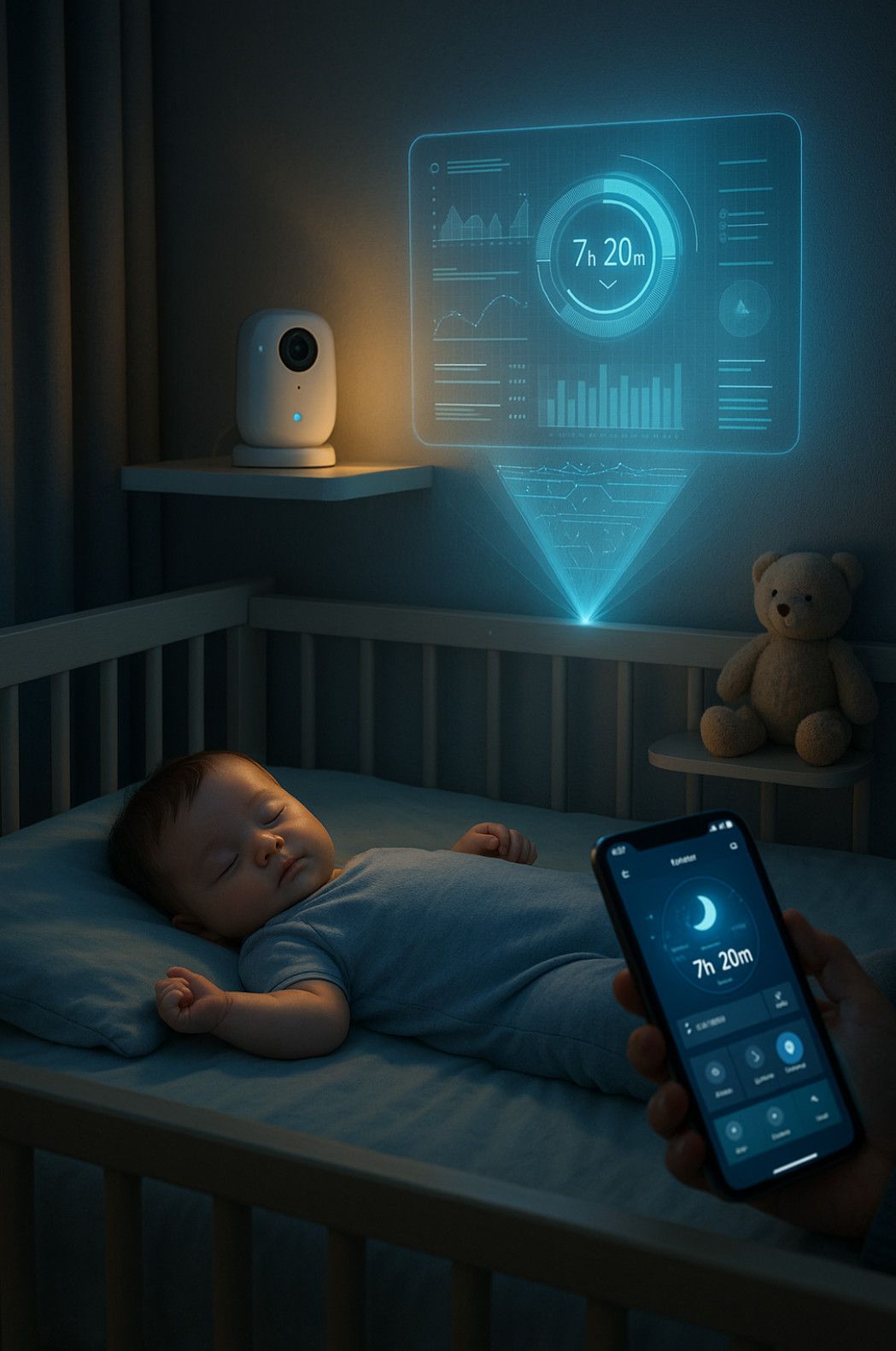
5. From Prototype to Parenting Partner: Why the App Is the Business—and Why Execution Matters
Every successful baby-tech product ends in the same place: a parent, half-asleep at two in the morning, opens an app and instantly decides whether to intervene or drift back to bed. That moment of absolute trust—or its absence—defines the commercial fate of an AI baby monitor far more than the accuracy of any single neural-network metric. You can train a cry-classification model to ninety-nine-percent precision in the lab, solder a medical-grade temperature sensor onto the PCB, and still watch the product fail because the push notification arrived ten seconds too late or the app demanded a firmware update while the baby was screaming. Section 5 is therefore less a conclusion than a reality check: for AI monitors, the mobile application is the product, the subscription, and the brand’s promise, all woven into one tap-to-open experience.
A first-rate app for an AI monitor must carry five loads at once. First, it is the low-latency command centre—receiving packet-compressed inference results, overlaying them on a reassuring waveform, and letting a parent scrub back through the past ninety minutes without buffering. Second, it is the behavioural coach, translating thousands of micro-events into a digestible narrative: “Average self-soothe time fell from eight minutes to five after you switched swaddles.” Third, it is the business model, surfacing premium features—white-noise personalisation, paediatric-validated sleep-stage scoring, tele-consult push-to-call—in gentle, value-based nudges rather than cynical paywalls. Fourth, it is the compliance shield, exposing GDPR consent toggles, CCPA data-deletion buttons, and HIPAA-grade encryption disclaimers in language that a sleep-deprived parent can skim at 3 a.m. And finally, it is the emotional bridge: the place where a mother in a hotel room nine hundred miles away presses Live View and sees her partner rocking the baby; where a father on shift receives a “soft-whimper” alert instead of a panic siren and smiles because he knows the system predicts self-settling.
Those loads generate a cascade of engineering and product decisions that only an end-to-end specialist can juggle. Edge AI models must be quantised to run on a 250-MHz DSP with ten milliamps to spare; otherwise battery life collapses and the monitor becomes a tethered camera—indistinguishable from commodity webcams. BLE pairing flows must complete under thirty seconds or return to trust-building start screens; every additional Wi-Fi handshake erodes the user’s confidence that the device will save them time rather than consume it. Cloud retention policies must default to fourteen days of encrypted video, long enough for weekly sleep-pattern audits but short enough to avoid accusations of surveillance capitalism. And the night-mode palette? It should adapt to iOS dark mode, because parents who nurse under amber night-lights do not appreciate a sudden blue flash from a mis-themed chart.
A-Bots.com earns its keep by making those cross-disciplinary trade-offs feel invisible. Our teams prototype with roll-forward tele-metry: every beta push builds a privacy-scrubbed usage histogram within six hours, revealing whether parents actually tap the “soothing heat-map” or simply glance at the heartbeat icon and close the app. Within two sprints we either promote or sunset a feature, preventing bloatware that drains battery and attention alike. We bake in an escalation ladder: a minor cry inference triggers a local lullaby recommendation; a prolonged distress sequence flips on two-way audio; a critical desaturation event calls emergency contacts and optionally 911 in jurisdictions where that is legal. No parent should dig through menus while adrenaline spikes; no engineer should wonder which corner case will wake legal counsel at dawn.
Investors tend to evaluate hardware gross margin, but in baby-tech the recurring software revenue is the engine that justifies each production run. When empirical sleep analytics halve night wakings for pilot families, renewal rates exceed ninety percent and referral codes flow organically through WhatsApp parenting groups. That kind of stickiness isn’t won on the shelf; it is won nightly when the app ping backs a “Still sleeping—98 % confidence” alert, followed by merciful silence. It is cemented each morning when the dashboard narrates progress in empathetic English instead of clinical jargon. And it is defended over time by an architecture that allows us to ship Model v4 breathing-rate detection to every legacy camera without requiring parents to read a change-log.
In a space where every competitor boasts “AI inside,” differentiation lives in how gracefully the software orchestrates silicon, cloud, and human emotion. Parents don’t buy inference precision; they buy the right to exhale and close their eyes for twenty minutes longer than yesterday. The companies that internalise that truth—and partner with teams who know how to translate sensor noise into visceral calm—will define the next era of infant care. The rest will ship plastic rectangles that blink, buffer, and ultimately end up in the overstuffed drawer of baby tech that promised magic but delivered static.
A-Bots.com intends to be on the right side of that drawer.
Technology Performance
- CryAssist™ launch (Maxi-Cosi See Pro 360°) demonstrates mainstream appetite for AI-speech classification to label hunger vs. discomfort cries doreljuvenile.com
- Nanit accuracy study—computer-vision sleep detection matched actigraphy with high sensitivity in lab tests ScienceDirect
- Cubo AI Nighttime Sleep Report: daily cloud-generated sleep dashboards inside the app validate parent demand for longitudinal analytics help.getcubo.com
Health & Safety Context
- AAP Safe-Sleep guidelines (updated 2022): back-sleeping, firm mattress, no soft objects—critical content to surface in onboarding flows Home | AAP
- U.S. live births 2023: 3.6 M infants—addressable domestic base Axios
Risk, Regulation & Trust
- Owlet Smart Sock FDA warning (2021)—illustrates need for clear regulatory pathway when claiming health metrics U.S. Food and Drug Administration
- Camera-hacking fears are widespread on parenting forums; encryption and user-permission dashboards are now decisive buying factors Reddit
- Miku bankruptcy + forced subscription (2024 community thread) shows how fragile trust erodes when cloud reliance is mishandled Reddit
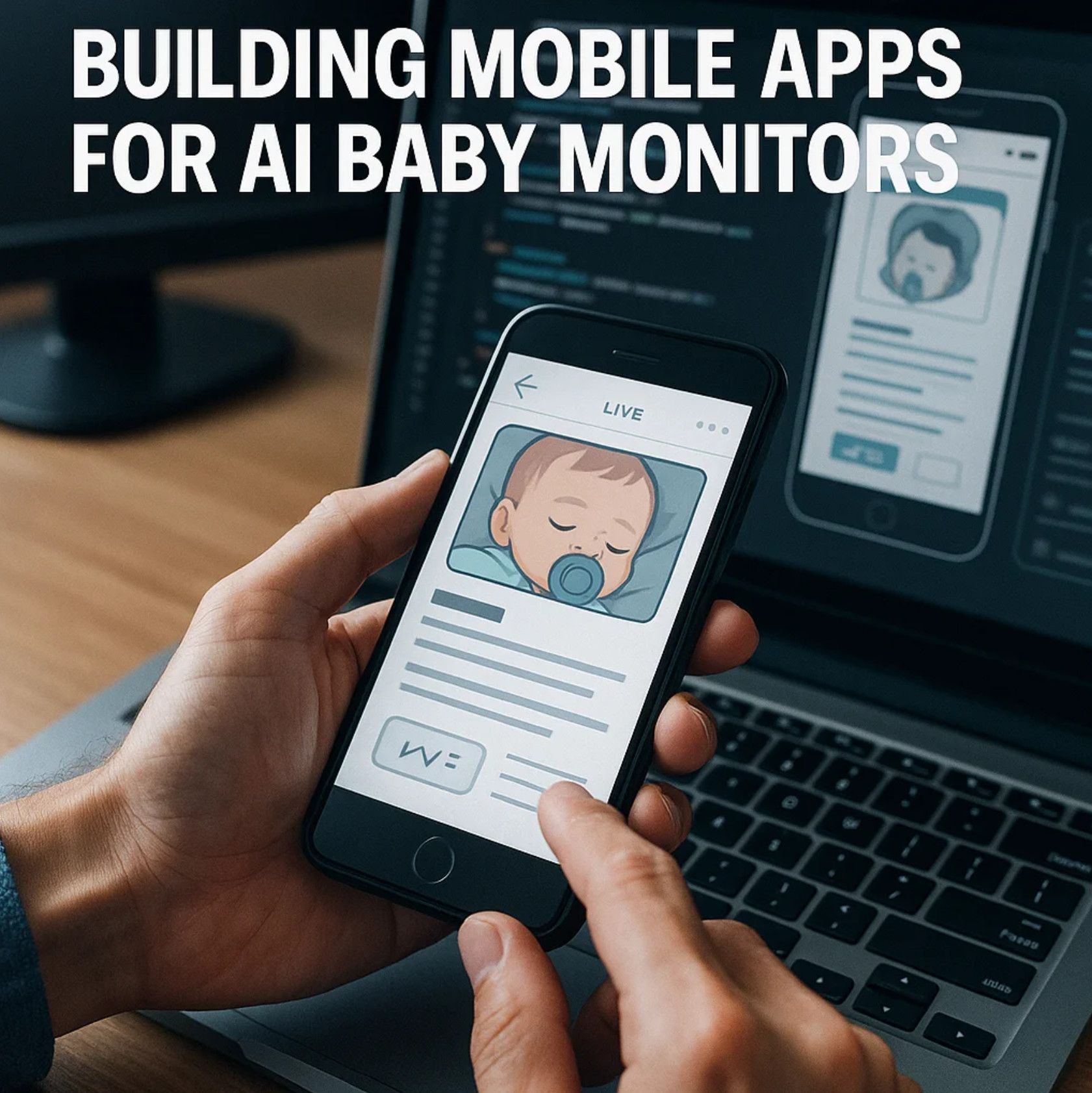
Why This Matters
- Strong market pull justifies custom-app budgets (US$2.7 B TAM).
- Clinical-grade expectations after Owlet/FDA story make accuracy & compliance prime selling points.
- Data-privacy headlines prove secure mobile UX is a competitive moat.
- Recurring-revenue turbulence (Miku) warns brands to future-proof cloud costs and comms.
The smart baby-monitor ecosystem is expanding rapidly as AI, computer vision and cloud analytics drive demand for devices that do far more than stream video. Market forecasts show the category passing US $2 billion by 2033, while venture capital keeps flowing into camera-and-sensor platforms such as Nanit, Cubo AI and Owlet. At the same time, parents, pediatricians and regulators are sharpening expectations around privacy, clinical accuracy and FDA oversight. The data below—covering market size, growth rates, technology performance, safety guidelines and business risks—forms a fact base you can cite throughout the forthcoming long-read on “Building Mobile Apps for AI Baby Monitors: From Cry Detection to Sleep Analytics.”
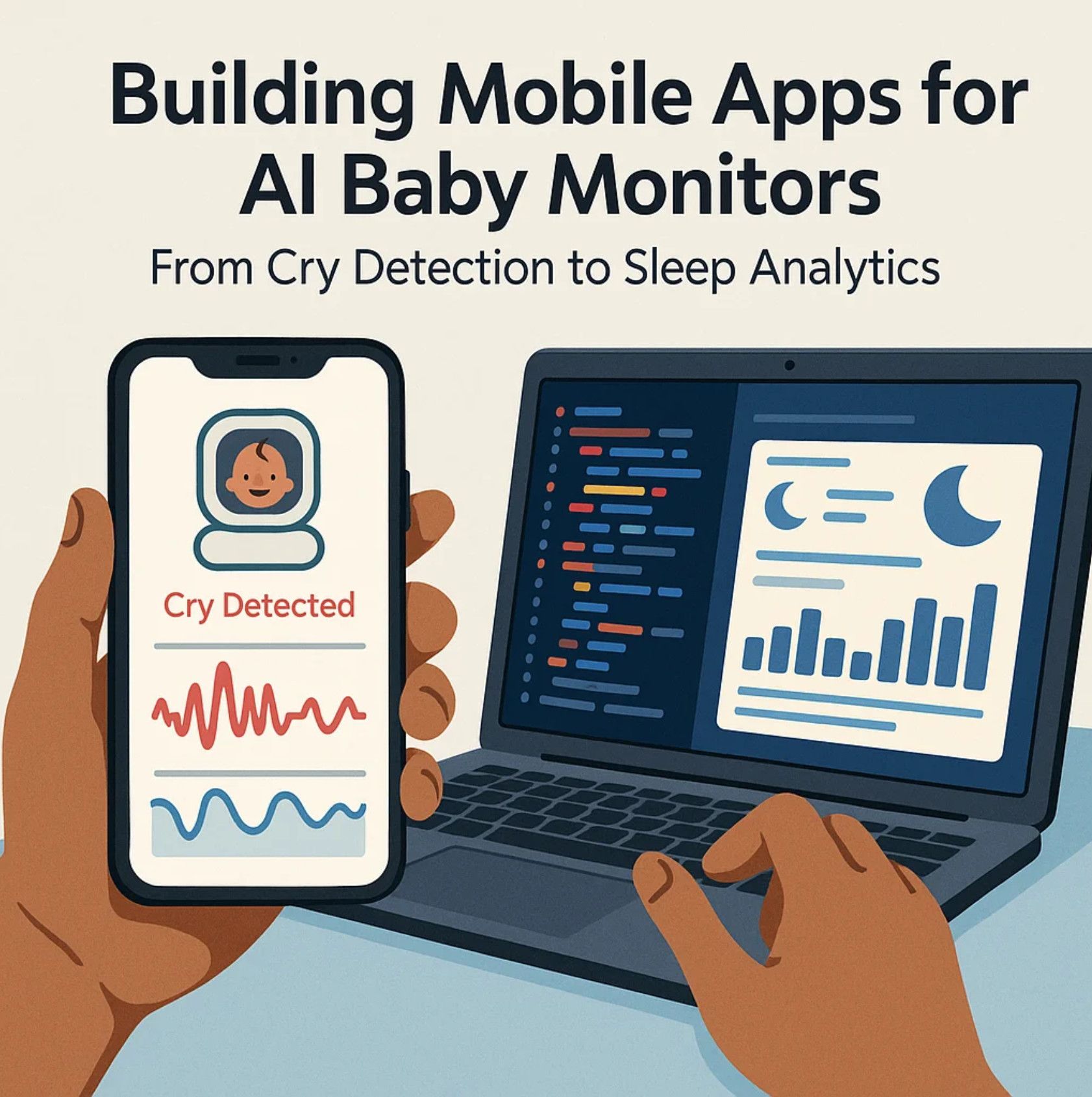
✅ Hashtags
#AIBabyMonitor
#ParentTech
#SleepAnalytics
#CustomAppDevelopment
#IoTDevices
#CryDetection
#MobileHealth
#ABots
#BabySafety
#SmartNursery
Other articles
Custom CRM for Real Estate Developers Off-the-shelf CRM tools weren’t built for the complexity of real estate development — but we were. This in-depth article explores why custom CRM solutions are redefining how developers manage projects, leads, teams, and revenue. See real-world ROI calculations, key challenges, and expert insights from A-Bots.com, a top CRM development company.
Custom Agriculture App Development for Farmers In 2024, U.S. farmers are more connected than ever — with 82% using smartphones and 85% having internet access. This article explores how mobile applications are transforming everyday operations, from drone-guided field scouting to livestock health tracking and predictive equipment maintenance. It examines why off-the-shelf apps often fail to address specific farm needs and how collaborative, farmer-funded app development is gaining momentum. Through real-world examples and step-by-step guidance, readers will learn how communities of growers can fund, design, and launch custom apps that fit their exact workflows. A-Bots.com offers tailored development services that support both solo farmers and agricultural groups. With offline capabilities, modular design, and support for U.S. and international compliance, these apps grow alongside the farm. Whether you're planting soybeans in Iowa, raising cattle in Texas, or running a greenhouse in California — this article offers the tools and inspiration to build your own farm technology. Discover why more farmers are saying: we don’t wait for the future — we build it.
Custom Drone Mapping Software & Control Apps: Smarter Aerial Solutions by A-Bots.com Custom drone software is revolutionizing how industries operate—from precision agriculture to infrastructure inspection. This article explores why off-the-shelf apps fall short, how AI and modular design shape the future, and how A-Bots.com delivers tailored drone solutions that truly fit. Whether you manage crops, assets, or entire projects, the right software lifts your mission higher.
Custom IoT for Smart Greenhouses and Vertical Farms Modern greenhouses and vertical farms demand more than off-the-shelf solutions. In this article, discover how custom IoT systems — built around your space, your crops, and your team — can unlock new levels of efficiency, automation, and yield. Packed with real-world examples, insights from A-Bots.com engineers, and expert advice, this guide will inspire your next step in smart agriculture. If you're ready to grow smarter — start here.
Custom Coffee Machine App Development Smart coffee is no longer just about flavor — it's about experience. Discover how custom mobile apps for coffee machines unlock new revenue streams, elevate user engagement, and enhance brand loyalty. Backed by real IoT projects, A-Bots.com delivers world-class app solutions that blend tech with taste. Brew the future with us.
Custom Mobile App Development for Smart Wine Cabinets Smart wine cabinets are revolutionizing how wine is stored, served, and experienced. But without a tailored mobile app, their potential remains untapped. This article explores how custom app development turns connected appliances into lifestyle platforms. From inventory tracking and AI-powered recommendations to enterprise-grade restaurant integrations, the right app changes everything. We cover technical architecture, design principles, and real-world use cases. Whether you're a wine lover, hotelier, or hardware brand, you'll discover why mobile UX is now core to wine storage. A-Bots.com delivers expert, future-ready solutions tailored to this niche.
Mobile App Development for Lawn Mowers Smart lawn mowers are transforming how homeowners and businesses manage outdoor spaces. But without powerful software, even the best mower is just hardware. This article explores how custom mobile apps enhance the robotic mowing experience with features like GPS mapping, dynamic scheduling, and real-time feedback. From residential use to commercial landscaping, the impact is clear. We examine the tech architecture behind connected mowers and the critical role apps play in user satisfaction. You'll also learn why off-the-shelf solutions fall short — and how A-Bots.com builds tailored experiences that go far beyond expectations. Whether you're a manufacturer or a visionary startup, this article offers a roadmap to the future of lawn automation.
Mobile App Development for Smart Pet Feeders Smart pet feeders are no longer luxury gadgets — they are becoming vital tools in modern pet care. But their true power is unlocked only through intuitive, connected mobile apps. This article explores how custom software development elevates the user experience far beyond off-the-shelf solutions. From feeding schedules to AI-driven health monitoring, we break down what pet owners truly expect. We analyze the market, dissect real product cases, and outline the technical architecture behind dependable smart devices. Most importantly, we show why hardware manufacturers need the right digital partner. A-Bots.com delivers the kind of app experience that builds trust, loyalty, and long-term value.
Mobile App Development for Scales Smart scales have evolved into intelligent health companions, offering far more than weight data. Today’s users demand full-body insights, AI-driven feedback, and smooth integration with other devices. This article explores how mobile apps transform smart scales into personalized wellness ecosystems. We analyze the market growth, user expectations, and technical architecture needed for success. Real-world case studies and forward-looking trends are covered in depth. We also reveal why brands must prioritize custom software over generic solutions. If you're building the future of digital health, it starts with your app.
Custom Mobile App Development for Window-Cleaning Robots Window-cleaning robots are moving from novelty to necessity as glass facades dominate modern architecture. But hardware alone cannot deliver safety, efficiency, or user trust. This article explains why a powerful mobile app—built for AI navigation, cloud analytics, and multi-device control—is now the true differentiator. We track a market expected to surpass $1.5 billion, analyze leading models, and expose the gaps in off-the-shelf software. You’ll see how custom apps cut maintenance costs, unlock fleet-level dashboards, and turn sensor data into product vision. The technical deep-dive shows exactly how BLE, Wi-Fi, and OTA updates converge inside a secure, scalable stack. If you manufacture cleaning robots, the path to premium positioning starts with smarter software.
Custom Mobile App Development for Smart Dog Collars The future of pet care is connected—and mobile apps are at the heart of it. This article explores how smart dog collars are evolving into real-time safety hubs, with integrated GPS, cameras, microphones, and LED displays. We analyze the global pet-tech boom and explain why software, not just hardware, drives loyalty and recurring revenue. You'll discover what pet owners want, what competitors miss, and how custom mobile apps turn simple sensors into premium services. A-Bots.com reveals the technical and UX patterns that create trust, conserve battery, and unlock delight. From bark detection to programmable LED scrolls, the app is where peace of mind happens. Learn how we help manufacturers lead the pack.
Mobile Apps for E-Bike or Scooter Urban mobility is shifting from private cars to agile fleets of shared e-bikes and scooters. Yet hardware alone cannot deliver uptime, safety, or profitability. The real engine is a custom mobile platform that unifies GPS, battery health, rider scoring, and dynamic pricing. This article dissects a market projected to exceed $50 billion by 2030 and shows why off-the-shelf dashboards fall short. We map the technical stack—from vehicle CAN-bus to real-time payment APIs—and expose hidden revenue levers like predictive maintenance and congestion-aware geofencing. Real-world examples illustrate both the growth hacks and the compliance pitfalls. Finally, we explain how A-Bots.com turns data exhaust into ROI for operators and safer rides for cities.
Top stories
Copyright © Alpha Systems LTD All rights reserved.
Made with ❤️ by A-BOTS
